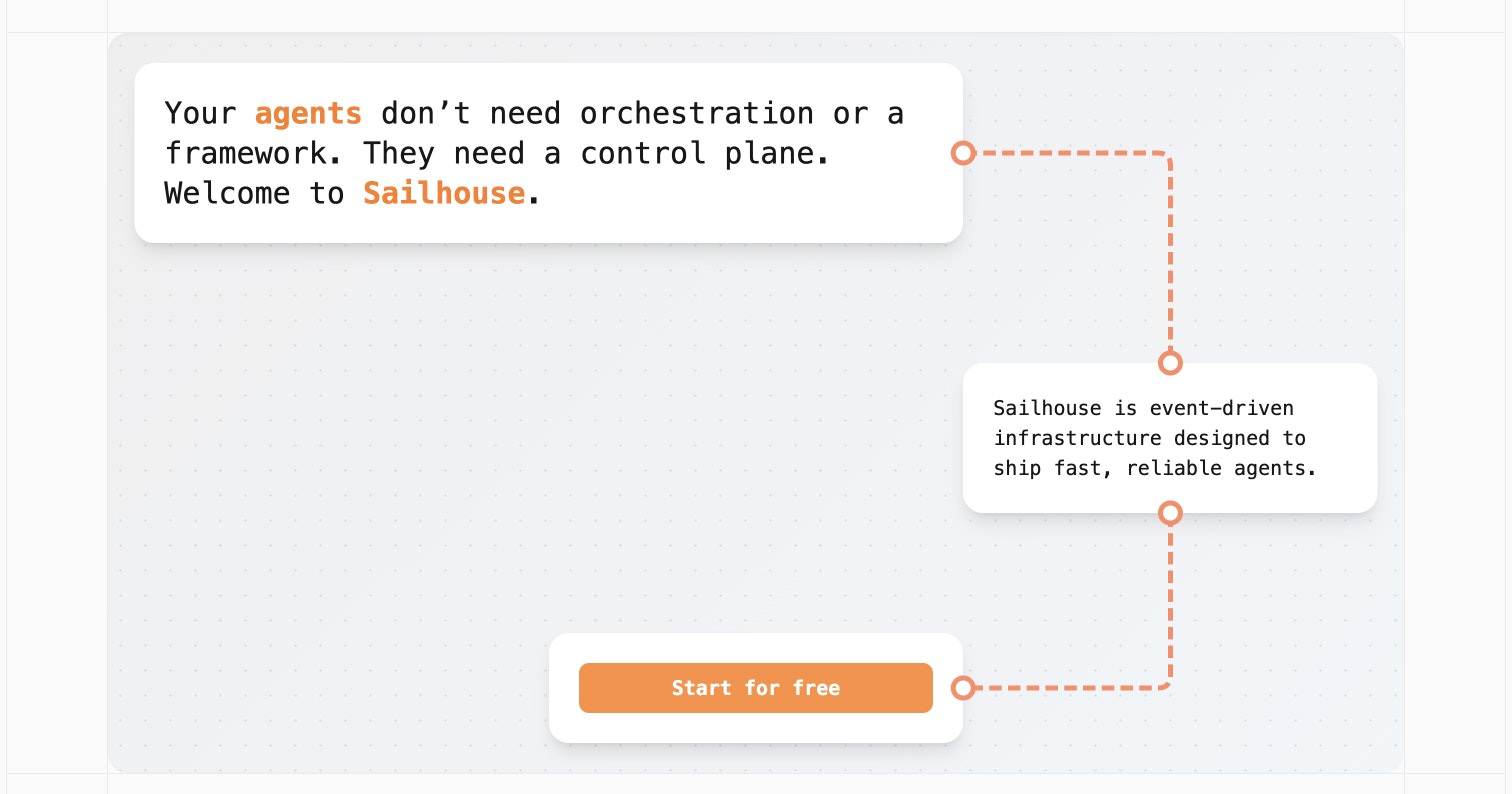
Table of Contents
Overview
In the rapidly evolving landscape of AI, coordinating intelligent agents and asynchronous systems presents significant operational challenges. Sailhouse emerges as a specialized control plane designed to address these complexities through code-defined dynamic workflows. This developer-focused platform delivers reliable message delivery, comprehensive real-time visibility, and production-grade coordination capabilities while maintaining a lightweight infrastructure footprint, making it particularly suited for modern AI development stacks.
Key Features
Sailhouse provides a comprehensive feature set engineered specifically for AI agent coordination and asynchronous system management.
- Event-driven agent coordination: Enables AI agents to respond dynamically to real-time triggers, facilitating seamless communication and task execution based on event streams
- Durable delivery guarantees: Ensures reliable message processing and state preservation across distributed environments, eliminating dropped messages and lost states that can compromise system integrity
- Real-time observability: Provides comprehensive logging, status tracking, and performance metrics through a centralized dashboard, delivering immediate insights into workflow execution
- Lightweight deployment: Features minimal infrastructure requirements for rapid integration into existing systems without extensive overhead or architectural changes
- Git-based workflows and configuration: Embraces GitOps principles by managing workflows and configurations directly through Git repositories, enabling version control, collaboration, and automated deployment pipelines
How It Works
Sailhouse operates through an elegant architecture that prioritizes developer experience and operational reliability. Developers define workflows using TypeScript, leveraging familiar programming constructs to create complex agent behaviors. These workflows deploy seamlessly via Git repositories, integrating naturally with existing CI/CD pipelines. Once deployed, workflows actively monitor for events from diverse data sources and other AI agents, triggering corresponding actions when conditions are met. The platform handles delivery reliability and state management automatically, abstracting infrastructure complexity while providing comprehensive monitoring through its intuitive dashboard interface.
Use Cases
Sailhouse’s flexible architecture supports diverse applications across AI agent coordination and asynchronous system management.
- AI agent orchestration: Coordinate multiple AI agents working collaboratively toward complex objectives, ensuring efficient task distribution and completion
- Real-time LLM workflows: Build responsive workflows around Large Language Models that react to events and trigger subsequent actions in real-time processing chains
- Event-based automation: Create sophisticated automation processes that respond to specific triggers, reducing manual intervention and improving operational efficiency
- Agent-to-agent communication: Establish robust communication channels between different AI agents, enabling information exchange and collaborative decision-making
- Infrastructure for async systems: Provide reliable, observable foundations for asynchronous systems requiring state management and execution guarantees
Pros \& Cons
Advantages
- Developer-centric design: TypeScript-based workflows and Git integration create familiar development patterns for rapid adoption
- GitOps workflow support: Native Git integration enables version control, collaborative development, and automated deployment strategies
- Comprehensive observability: Built-in dashboard provides real-time logs, status monitoring, and performance metrics for complete workflow visibility
- AI-native architecture: Purpose-built features specifically address the unique challenges of LLM agent orchestration and coordination
Disadvantages
- Programming knowledge requirement: Developers need TypeScript proficiency to define and manage workflows, creating barriers for non-technical users
- Emerging platform limitations: As a newer solution, capacity for extremely high-throughput, mission-critical systems continues evolving
- Evolving feature ecosystem: While robust, the platform continuously develops new capabilities, meaning some advanced features may still be on the development roadmap
How Does It Compare?
When evaluating Sailhouse against current AI orchestration and workflow management solutions, its specialized focus on agent control planes distinguishes it from broader approaches. LangChain with LangGraph provides comprehensive LLM application development with graph-based workflow orchestration, offering extensive tool integrations and retrieval-augmented generation capabilities, but requires deeper ML expertise and carries heavier computational overhead.
Microsoft AutoGen excels in conversational multi-agent scenarios with sophisticated dialogue coordination and Azure ecosystem integration, making it ideal for chat-based applications but less optimized for event-driven workflows. CrewAI structures agents as specialized teams with role-based coordination, providing excellent task delegation for defined workflows but offering less flexibility for dynamic, event-responsive systems.
Temporal delivers enterprise-grade workflow orchestration with strong durability guarantees and complex state management, supporting multiple programming languages and handling mission-critical processes. However, it requires dedicated server infrastructure and has a steeper learning curve compared to Sailhouse’s lightweight approach.
Apache Airflow dominates batch-oriented workflow scheduling with extensive integrations and Python-based DAG definitions, but focuses on scheduled processes rather than real-time event-driven agent coordination. OpenAI Swarm offers experimental multi-agent handoff patterns with minimal overhead, though it remains in early development phases.
Sailhouse differentiates itself through its event-driven architecture specifically optimized for AI agent coordination, GitOps-native workflow management, and lightweight deployment model. Its TypeScript-first approach appeals to web developers, while its agent-centric design addresses coordination challenges that general workflow tools don’t fully solve. The platform excels in scenarios requiring real-time agent communication, dynamic workflow adaptation, and minimal infrastructure overhead.
Final Thoughts
Sailhouse represents a focused approach to AI agent orchestration, addressing the specific challenges of coordinating intelligent agents in production environments. Its emphasis on developer experience through TypeScript workflows, Git-based deployment, and comprehensive observability positions it as a compelling choice for teams building event-driven AI systems. While the platform requires programming expertise and continues maturing, its specialized agent control plane architecture and lightweight infrastructure model make it particularly valuable for developers seeking reliable, scalable solutions for AI agent coordination without the complexity of enterprise workflow engines. The platform’s rapid development and growing community adoption suggest strong potential for teams prioritizing developer velocity and operational simplicity in their AI infrastructure.

